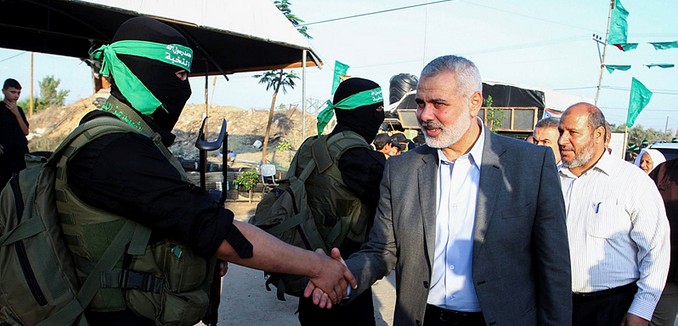Hamas leader Ismail Haniyeh revealed that the terrorist organization makes no distinction between its civilian and military “wings,” vowing in a statement on Hamas’ website to take payments intended for government employees and funnel them to “military personnel.”
Qatar recently agreed to transfer $31 million to Hamas in order to pay government workers, who over the past three years have only received around one-third to one-half of their official salaries. In response, Haniyeh stated that the payments will go to pay all of the terrorist organization’s employees, including its fighters. He rejected those who say that there is a distinction between Hamas’ military and civilian employees, saying that both are “legitimate” because both have been “appointed by the decision of a legitimate government.”
The statement was first reported in English by The Times of Israel.
While the United States and other countries have designated Hamas as a terrorist organization, the United Nations distinguishes between Hamas’ political organization and its military wing, the Izz ad-Din al-Qassam Brigades.
Three years ago, the European Union designated only Hezbollah’s military wing as a terrorist organization, despite the admission of a Hezbollah spokesman that the group has a unified leadership and no separate wings of the organization.
Despite the damage done to houses in Gaza during Operation Protective Edge two years ago, Hamas has been using its money and resources to prepare for the next war with Israel. Unnamed Israeli official last week estimated that Hamas was digging six miles of terror tunnels every month.
Since the end of the 2014 Gaza war, the Israeli Defense Forces discovered two Hamas tunnels that extended into Israeli territory—one in April and another in May. Israel destroyed 34 tunnels during the 50-day conflict and has since invested an estimated one billion shekels ($250 million) in tunnel detection technology. A Hamas operative who was captured in June after illegally crossing into Israel revealed that the terrorist group’s fighters can travel underground throughout the entirety of Gaza.
Brig. Gen. (res.) Yossi Kuperwasser, the former director general of Israel’s Ministry of Strategic Affairs, told reporters in May that the discovery of the tunnels was a sign that Hamas was preparing for another war against Israel. He added that the tunnel digging means that “they definitely invest a lot in making the necessary preparations so that in the next round, when they decide to start it, they will be able to inflict the heaviest damage on Israel, including through those tunnels.”
Haaretz defense correspondent Amos Harel wrote in January that “Hamas is investing great efforts and huge sums in the tunnel project. It is reasonable to assume that the number of tunnels crossing under the border is close to that on the eve of Protective Edge,” or the 2014 Gaza war.
In Your Complete Guide to Hamas’ Network of Terror Tunnels, which was published in the April 2016 issue of The Tower Magazine, Dan Feferman underscored that it is the people of Gaza who are paying the price for Hamas’ decision to prioritize war with Israel over their wellbeing.
There is a tragic side to Hamas’ tunnel strategy. Roughly 9,000 homes were destroyed during Protective Edge, and very few have been rebuilt. This is not Israel’s fault, as building supplies flow regularly into Gaza. But according to declassified intelligence reports, these supplies are routinely stolen by Hamas in order to serve the group’s terrorist purposes. Hamas smuggles in cement, diverts from construction and humanitarian donations, and even raids civilian construction sites in order to rebuild its tunnels. Estimates are that one tunnel can cost a million dollars to build and uses around 50,000 tons of concrete. Close to a million tons of concrete were poured into the terror tunnels before 2014.
The tunnels, in this sense, are a zero-sum game. If the same materials were put into reconstruction, the Gazan people would be better off and, lacking this crucial asymmetric warfare capability, Hamas would be less tempted to attack Israel. On the other hand, with the same limited materials going to terror tunnels, the people of Gaza continue to live in ruins while Hamas rebuilds its war machine.
While Hamas appears to be deterred in the short term, it continues to believe that the tunnels are its only strategic weapon. While it may not be interested in another war, the tunnels continue to be dug for a reason. Once used, however, they lose their effectiveness, as the IDF knows their locations and can thus destroy them. Hamas is well aware of this dilemma. The tunnels essentially leave Israel and Hamas in an arms race—with Israel racing to develop a technological solution before Hamas decides to launch another round of fighting.
[ Abed Rahim Khatib / Flash 90 ]




